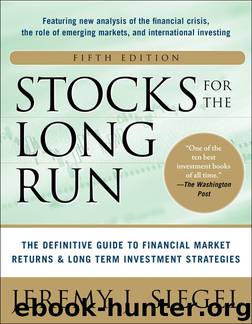Stocks for the Long Run 5E by Jeremy J. Siegel

Author:Jeremy J. Siegel
Language: eng
Format: epub
Publisher: McGraw-Hill Education
Published: 2014-04-02T04:00:00+00:00
STOCKS AS HEDGES AGAINST INFLATION
Although the central bank has the power to moderate (but not eliminate) the business cycle, its policy has the greatest influence on inflation. As noted above, the inflation of the 1970s was due to the overexpansion of the money supply, which was an action the central bank took in the vain hope that it could offset the impact of the OPEC oil supply restrictions. This expansionary monetary policy brought inflation to double-digit levels in most industrialized economies, peaking at 13 percent per year in the United States and exceeding 24 percent in the United Kingdom.
In contrast to the returns of fixed-income assets, the historical evidence is overwhelming that the returns on stocks over long time periods have kept pace with inflation. Since stocks are claims on the earnings of real assets—assets whose value is intrinsically related to the price of the goods and services they produce—one should expect that their long-term returns will not be harmed by inflation. For example, the period since World War II has been the most inflationary period in our history, and yet the real returns on stocks have matched that of the previous 150 years. The ability of an asset such as stocks to maintain its purchasing power during periods of inflation makes equities an inflation hedge.
Indeed, stocks were widely praised in the 1950s as hedges against rising consumer prices. As noted in Chapter 11, many investors stayed with stocks at that time, despite seeing the dividend yield on equities fall below the interest rate on long-term bonds. In the 1970s, however, stocks were ravaged by inflation, and it became unfashionable to view equities as an effective hedge against inflation.
What does the evidence say about the effectiveness of stocks as an inflation hedge? The annual compound returns on stocks, bonds, and Treasury bills against inflation over 1-year and 30-year holding periods from 1871 to 2012 are shown in Figure 14-3.
Download
This site does not store any files on its server. We only index and link to content provided by other sites. Please contact the content providers to delete copyright contents if any and email us, we'll remove relevant links or contents immediately.
Rich Dad Poor Dad by Robert T. Kiyosaki(6175)
Pioneering Portfolio Management by David F. Swensen(6079)
How To Win Friends and Influence People by Dale Carnegie(4332)
The Money Culture by Michael Lewis(3846)
The Dhandho Investor by Mohnish Pabrai(3560)
The Wisdom of Finance by Mihir Desai(3523)
Liar's Poker by Michael Lewis(3222)
The Intelligent Investor by Benjamin Graham Jason Zweig(2930)
The ONE Thing by Gary Keller(2918)
Mastering Bitcoin: Programming the Open Blockchain by Andreas M. Antonopoulos(2891)
Fooled by Randomness: The Hidden Role of Chance in Life and in the Markets by Nassim Nicholas Taleb(2860)
Rich Dad Poor Dad: What The Rich Teach Their Kids About Money - That The Poor And Middle Class Do Not! by Robert T. Kiyosaki(2834)
Investing For Dummies by Eric Tyson(2794)
How to Win Friends and Influence People by Dale Carnegie(2793)
How to Day Trade for a Living: Tools, Tactics, Money Management, Discipline and Trading Psychology by Andrew Aziz(2785)
Market Wizards by Jack D. Schwager(2539)
Zero Hour by Harry S. Dent Jr. & Andrew Pancholi(2533)
How to Pay Zero Taxes, 2018 by Jeff A. Schnepper(2500)
Rich Dad's Guide to Investing by Robert T. Kiyosaki(2411)
